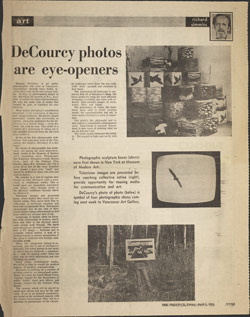ART - De Courcy photos are eye-openers
THE PROVINCE - Friday, April 2, 1971
By Richard Simmins
Michael de Courcy is an artist-photographer who lives in Vancouver. Information, through mass media, involves him with world and cosmos reality. In turn, by participating deeply in his individual life process in B.C. he is able to exhibit his ideas internationally. He uses the same type of media that helped in part to condition his own thinking.
What makes de Courcy's contribution important is his awareness of physical and image existence. His direct, simple philosophy relates him irrevocably to nature, gives him guidelines for his fulfillment as a human being - even dictates the food he eats. This artist is a symbol of a generation to whom art is not possible divorced from the life style that creates it.
In two of the four photographic exhibitions that open next week at the Vancouver Art Gallery de Courcy is a key figure.
His stacks of photographic box sculptures are among the most impressive, stark works in the Museum of Modern Art's circulating show, Photography Into Sculpture. De Courcy's book, Seasons Cycle, part of the National Film Boards show, B.C. Almanac(h) C-B is great. It is one of the most beautiful love stories I have ever "read" and should be studied by those who love and want to marry.
The camera is a tool to capture new images of what de Courcy calls a processed or conditional reality. This is based upon our immediate experience with nature, either through media or the physical conditions through which we observe it.
Television images are processed many times before they reach the collective retina. They move from film to video tape to electronic impulses and back to recognizable form. Newspaper photographs lose 30% of their clarity before being restructured as halftones which are circular dots of ink.
Landscape in motion, when we drive, has little relationship in texture smell form and color to the physical space some people walk through. The earth seen through an aircraft window resembles a TV image - flattened and in constant lateral motion. A map of a lived-in terrain is almost meaningless if the form is cluttered with foreign unintelligible words.
Ideas, like image loss, belong to everybody and this is one of de Courcy's concerns. For every person in our society who is directly involved - conscientiously, with the neutral order, there are nine who get their information and conditioning via media.
Using visual, technological reality, the artist is able to record the positive of aspects of modern communication.
De Courcy is working on a number of exciting projects, an interrelated series. There is a book for Coach House Press, Toronto; murals for the Department of Public Woks' rural post offices, and a mosaic of visuals for The National Film Board.
The murals which will be placed in small post offices and may be the only work of art in an isolated community, are based on his continued concern with the window environment. They will be a montage of photographs of the Canadian landscape taken from the air - with 2,000 miles spanned and recorded in four hours. The abstraction is consistent with all of de Courcy's ideas. hHis boxes produced using the most efficient technology available are cubes with reduced, high-contrast images of rocks, water, birds and clouds. The persistence of vision, the insistence upon what is really re-using media for communication and art, is what makes de Coucy's work so important.
This artist's life, philosophy and vision reflect a remarkable contemporary unit. Experiment is constant. Experiment is new ways of ordering of what we all see but don't see. The single image embraces totality. The seagull is flight and we fly with it.
Photographic sculpture boxes (above) were first shown in New York at Museum of Modern Art.
Television images are processed before reaching collective retina (right), provide opportunity for reusing media for communication and art.
De Courcy's photo of photo below is symbol of four photographic shows coming next week to the Vancouver Art Gallery.
